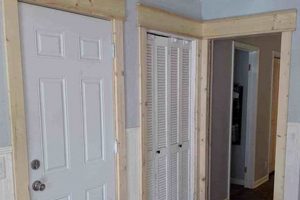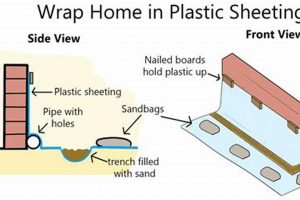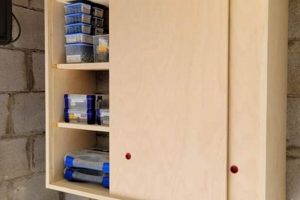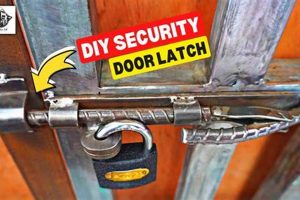The process involves adding insulating material to a garage door to improve its thermal resistance. This typically entails selecting appropriate insulation, cutting it to size, and securing it to the door panels. A common example includes fitting rigid foam boards into the recessed panels of a sectional garage door.
The advantages of improving a garage door’s insulation include reducing energy consumption within the garage and any adjacent living spaces, minimizing temperature fluctuations, and potentially dampening noise. Historically, the practice has gained traction alongside growing awareness of energy efficiency and the desire for more comfortable home environments.
The following sections will detail material selection, installation techniques, safety considerations, and cost analysis for optimizing a garage’s thermal performance through the discussed procedure. Subsequent content will further explore the necessary tools and provide step-by-step instructions.
Essential Considerations for Optimizing Garage Door Insulation
The following suggestions offer valuable guidance to ensure a successful and effective garage door insulation project.
Tip 1: Material Selection is Paramount: Evaluate the R-value of various insulation materials. Higher R-values indicate greater thermal resistance. Consider factors such as climate and desired temperature control when making a selection.
Tip 2: Accurate Measurements are Critical: Precise measurements of each door panel’s dimensions are essential. Inaccurate measurements can result in gaps, compromising the insulation’s effectiveness and creating potential aesthetic issues.
Tip 3: Ensure Proper Adhesion: Use appropriate adhesive products compatible with both the insulation material and the garage door surface. Inadequate adhesion can lead to insulation panels detaching over time, necessitating repairs.
Tip 4: Seal All Gaps and Edges: Apply weather stripping or caulk to seal any gaps around the perimeter of the insulated door. Air infiltration can negate the benefits of even the most effective insulation material.
Tip 5: Prioritize Safety Measures: Wear appropriate protective gear, including gloves, safety glasses, and a dust mask, during the installation process. Certain insulation materials can cause skin or respiratory irritation.
Tip 6: Consider Door Weight: Be mindful that adding insulation increases the weight of the garage door. Ensure that the door’s springs are properly adjusted to accommodate the additional weight, preventing operational issues.
Tip 7: Research Local Building Codes: Investigate any local building codes or regulations pertaining to garage door insulation. Compliance with these regulations is essential to avoid potential fines or complications.
Adhering to these recommendations ensures a well-insulated garage door, contributing to energy savings, improved comfort, and reduced noise transmission.
The subsequent sections of this article will address frequently asked questions and offer troubleshooting advice for common installation challenges.
1. Material R-Value
Material R-value is a critical factor in garage door insulation. It quantifies a material’s resistance to heat flow, directly impacting the effectiveness of any insulation project. Understanding R-value is fundamental to selecting the appropriate materials and achieving desired thermal performance.
- Definition and Measurement
R-value represents the thermal resistance of a material per unit area. Higher R-values indicate superior insulating capabilities. It is typically measured in units of Ffth/BTU (US customary) or Km/W (SI units). Manufacturers generally provide R-values for their insulation products, but independent testing verifies these claims.
- Impact on Thermal Performance
The R-value of insulation directly correlates with the reduction in heat transfer through the garage door. A higher R-value will result in a more stable internal temperature, reducing the need for heating or cooling. For example, upgrading from an uninsulated door (R-1 to R-3) to an insulated door with R-10 or higher can significantly decrease energy loss, especially in climates with extreme temperature variations.
- Material Selection Considerations
Various insulation materials possess different R-values per unit thickness. Common options include fiberglass batts, rigid foam boards (polystyrene, polyurethane, polyisocyanurate), and reflective foil insulation. Rigid foam boards generally offer higher R-values than fiberglass for the same thickness. The selection process should consider both the R-value and the space available within the garage door panels.
- Cost-Effectiveness
While higher R-value insulation typically involves a greater upfront cost, the long-term energy savings can offset this initial investment. A cost-benefit analysis should be conducted, factoring in local energy prices and climate conditions, to determine the most economically viable R-value for the specific application. Over-insulating can lead to diminishing returns, whereas under-insulating may not provide sufficient thermal protection.
The selection of an appropriate insulation material hinges on the interplay between R-value, cost, and available space. A careful assessment of these factors, along with consideration of installation complexity and desired thermal performance, is crucial for a successful project. Choosing a material with an appropriate R-value is the foundation of a well-insulated garage door, enhancing energy efficiency and overall comfort.
2. Accurate Panel Measurement
Accurate panel measurement forms a cornerstone of successful garage door insulation. The procedure necessitates precise dimensions for each panel to ensure a proper fit of the insulation material. Inaccurate measurements directly result in gaps or overlaps, compromising the thermal barrier and reducing the overall effectiveness of the insulation project. This relationship between precision and performance highlights the importance of meticulous measurement as a critical preparatory step.
As an example, consider a standard sectional garage door. If panel measurements are underestimated by even a quarter of an inch, multiple small gaps accumulate across all panels. These gaps allow air infiltration, negating the insulating properties of the installed material. Conversely, overestimated measurements necessitate excessive trimming or modification of the insulation, potentially damaging the material and leading to ill-fitting sections. From a practical perspective, correct measurements save both time and resources, minimizing material waste and rework. Furthermore, a precise fit enhances the aesthetic appearance of the insulated door, preventing unsightly gaps or overlaps. A well-measured and insulated door also contributes to its structural integrity, reducing vibrations and potential for damage from external elements.
In summary, accurate panel measurement is not merely a preliminary task; it is an integral component that directly influences the thermal performance, cost-effectiveness, and aesthetic outcome of a garage door insulation project. The challenge of managing variability in door panel construction underscores the importance of careful measurement techniques and the selection of insulation materials that can accommodate minor discrepancies. The value of precise measurements extends beyond the immediate project, contributing to long-term energy savings and enhanced home comfort.
3. Secure Adhesive Application
Secure adhesive application plays a vital role in garage door insulation projects. The effectiveness of the insulation relies not only on the R-value of the material but also on its sustained contact with the door panel. Improper or inadequate adhesion results in insulation detachment, leading to diminished thermal performance and potential safety hazards. The relationship is causal: insufficient adhesive leads directly to compromised insulation.
The selection of the appropriate adhesive is paramount. The chosen product must exhibit compatibility with both the insulation material and the garage door surface, be it metal, wood, or composite. Surface preparation, including cleaning and degreasing, is similarly crucial to ensure a strong bond. Consider the environmental conditions the garage door is exposed to, such as extreme temperatures or humidity, and choose an adhesive rated for those conditions. For example, using construction-grade adhesive formulated for exterior use can prevent premature failure due to temperature fluctuations. Proper application techniques, such as applying the adhesive in consistent beads or covering the entire surface, ensure uniform coverage and prevent weak spots. The practical significance of secure adhesion is evident in the prevention of insulation sagging, reduced energy bills, and maintained structural integrity of the door.
In summary, secure adhesive application is not a peripheral detail but a central requirement for successful garage door insulation. Attention to adhesive selection, surface preparation, and application technique directly impacts the long-term performance and safety of the insulated garage door. Ignoring this component undermines the entire insulation effort, leading to wasted materials and reduced energy savings. The implications extend beyond financial considerations, impacting the comfort and durability of the garage door itself.
4. Comprehensive Air Sealing
Comprehensive air sealing is integral to any garage door insulation project. Its effectiveness dictates the degree to which the benefits of insulation are realized. Inadequate attention to air sealing compromises the thermal barrier created by insulation, diminishing energy savings and negating the intended comfort enhancements.
- Perimeter Gap Mitigation
Gaps around the garage door perimeter constitute a major source of air infiltration. Weather stripping, installed along the door’s edges and bottom, effectively seals these gaps. Regular inspection and replacement of worn weather stripping are essential for maintaining an airtight seal. For instance, a deteriorated bottom seal allows cold air and moisture to enter during winter, and hot air during summer.
- Panel Joint Sealing
Sectional garage doors have joints between panels that can allow air leakage. Applying caulk or specialized foam tape along these joints creates an airtight barrier. Choosing a flexible sealant accommodates the door’s movement without cracking or losing adhesion. Gaps along panel joints may result from poor initial manufacturing tolerances or from the door becoming misaligned.
- Top Seal Implementation
The top section of a garage door requires a dedicated seal to prevent air exchange between the door and the header. A top seal effectively bridges this gap, especially in older homes where structural settling may create irregular openings. Not implementing a top seal causes the warm air to escape from top and increase energy bill during winter.
- Addressing Structural Infiltration
Air infiltration may also occur through cracks in the garage walls or around window frames. Addressing these structural leaks with caulk or expanding foam complements the door insulation efforts. A holistic approach to air sealing ensures that the garage is effectively isolated from external temperature fluctuations. Failing to address structural leaks will only increase energy bill.
By addressing the perimeter, panel joints, top section, and surrounding structure, comprehensive air sealing maximizes the effectiveness of garage door insulation. This meticulous approach enhances energy efficiency, improves comfort, and reduces the risk of moisture-related damage within the garage.
5. Spring Tension Adjustment
Spring tension adjustment is a critical mechanical consideration often overlooked within the context of garage door insulation. The added weight of insulation materials significantly alters the door’s operational balance, potentially leading to premature wear, safety hazards, and compromised functionality. Therefore, understanding and addressing spring tension becomes an essential component of any comprehensive garage door insulation endeavor.
- Weight Compensation
The primary function of garage door springs is to counterbalance the weight of the door, enabling smooth and controlled operation. Adding insulation increases the overall weight, requiring a corresponding adjustment to spring tension. Failure to compensate results in the door becoming difficult to open or close, placing undue stress on the opener mechanism, and potentially causing it to fail. If the door became difficult to open, garage door spring will break at some point.
- Operational Safety
Incorrect spring tension poses a significant safety risk. A door that is too heavy may unexpectedly slam shut, posing a threat of injury or damage. Conversely, a door that is too light may not remain fully closed, compromising security. Properly adjusted springs ensure that the door remains safely balanced throughout its range of motion. It also avoid door slamming when opening or closing it.
- Spring System Types
Garage doors utilize either torsion springs or extension springs, each requiring different adjustment procedures. Torsion springs are mounted horizontally above the door and adjusted by winding or unwinding the spring. Extension springs are located on either side of the door and adjusted by relocating the spring on the track. Correct identification of the spring type is essential before attempting any adjustments.
- Professional Assistance
Spring tension adjustment can be hazardous and requires specialized tools and knowledge. Incorrect adjustments can lead to serious injury. If there is any uncertainty regarding the procedure, seeking assistance from a qualified garage door technician is strongly recommended. The cost of professional adjustment is often minimal compared to the potential consequences of a DIY mishap.
These facets highlight the interdependence between garage door insulation and spring tension. Ignoring the mechanical implications of added weight can undermine the benefits of improved thermal performance, potentially leading to safety risks and costly repairs. Prioritizing proper spring adjustment ensures that the insulated garage door operates safely, efficiently, and reliably for years to come. The consequences of neglecting spring tension adjustment extend beyond operational inconvenience, impacting safety and long-term system integrity.
6. Safety Gear Usage
The implementation of garage door insulation projects, while seemingly straightforward, necessitates strict adherence to safety protocols. Appropriate safety gear usage is paramount, mitigating potential hazards associated with material handling, cutting, and installation procedures. Neglecting these precautions exposes individuals to preventable risks, thereby compromising project safety and well-being.
- Eye Protection
The cutting and handling of insulation materials, particularly fiberglass and rigid foam, generate dust and particulate matter. These particles pose a direct threat to ocular health, potentially causing irritation, corneal abrasion, or more severe injury. Safety glasses or goggles provide a physical barrier, shielding the eyes from these airborne hazards. For example, failure to wear eye protection while cutting fiberglass insulation may result in splinters becoming embedded in the eye, necessitating medical intervention.
- Respiratory Protection
Certain insulation materials release microscopic fibers or volatile organic compounds (VOCs) during installation. Inhaling these substances can irritate the respiratory system, triggering coughing, shortness of breath, or exacerbating pre-existing respiratory conditions. A dust mask or respirator effectively filters out these airborne contaminants, protecting the lungs. For instance, prolonged exposure to fiberglass dust without respiratory protection may lead to chronic respiratory irritation or, in severe cases, lung damage.
- Hand Protection
Many insulation materials, such as fiberglass, can cause skin irritation or allergic reactions upon contact. The sharp edges of cut insulation panels and the use of adhesives also present potential hazards. Gloves provide a protective barrier, preventing skin contact with irritants and minimizing the risk of cuts or abrasions. As an example, handling rigid foam insulation without gloves may result in skin irritation and the transfer of adhesive residue to the hands.
- Appropriate Attire
Wearing long sleeves and pants minimizes skin exposure to insulation materials, further reducing the risk of irritation. Loose-fitting clothing should be avoided to prevent entanglement with tools or equipment. Sturdy footwear protects the feet from dropped objects and sharp debris. Proper attire serves as an additional layer of defense, contributing to overall safety during the insulation process.
These facets emphasize the indispensable nature of safety gear usage within the context of garage door insulation. The proactive implementation of these measures minimizes the risk of injury, ensuring a safe and successful project outcome. Failure to adopt these practices unnecessarily elevates the potential for harm, undermining the benefits of improved energy efficiency and home comfort.
Frequently Asked Questions
The following addresses common inquiries and concerns regarding the process of enhancing a garage door’s thermal properties through self-performed insulation.
Question 1: What R-value is recommended for garage door insulation?
The appropriate R-value depends on climate and desired temperature stability. In colder climates, an R-value of 8 or higher is advisable. Warmer climates may require a lower R-value, typically between 4 and 8.
Question 2: Can any type of insulation material be used on a garage door?
No. Heavy or pliable materials, such as blown-in cellulose or standard fiberglass batts, are generally unsuitable. Rigid foam boards (polystyrene, polyurethane, polyisocyanurate) and reflective foil insulation are common and effective choices.
Question 3: Will insulation significantly increase the weight of the garage door?
Insulation adds weight, but typically not excessively. However, it is crucial to assess the weight increase and adjust the garage door springs accordingly to maintain proper balance and prevent operational issues.
Question 4: Is professional installation superior to a self-performed procedure?
Professional installation ensures expertise and proper technique, which can result in optimal thermal performance and longevity. However, with meticulous planning and adherence to instructions, a self-performed insulation can yield satisfactory results.
Question 5: What are the potential drawbacks of improper insulation?
Improper insulation can lead to reduced thermal performance, moisture accumulation, and potential damage to the garage door. Inadequate sealing can negate the benefits of the insulation, while excessive weight can strain the door mechanism.
Question 6: Does garage door insulation affect the door’s warranty?
Modifying a garage door by adding insulation may void the manufacturer’s warranty. Consult the warranty documentation or contact the manufacturer to ascertain the implications before proceeding.
Addressing the questions outlined provides insight into the parameters and considerations involved in garage door insulation. Careful evaluation of these aspects contributes to the success of the project.
The subsequent material will offer troubleshooting guidance for common problems encountered during garage door insulation installation.
Garage Door Insulation DIY
This exploration of garage door insulation DIY has emphasized the critical elements involved in achieving effective thermal control. The selection of appropriate insulation materials, the precision of panel measurements, the application of secure adhesives, and the imperative of comprehensive air sealing have been delineated as fundamental components. Furthermore, the necessity of accounting for spring tension adjustments and prioritizing safety gear usage has been underscored. The omission of any of these aspects can compromise the overall efficacy and safety of the project.
Ultimately, a successful garage door insulation DIY endeavor hinges upon a comprehensive understanding of the involved processes and a meticulous adherence to established guidelines. Continued diligence in the maintenance and upkeep of insulated garage doors will ensure sustained energy savings and improved environmental conditions. Further research into evolving insulation technologies and best practices remains crucial for optimizing the long-term performance of such installations.







